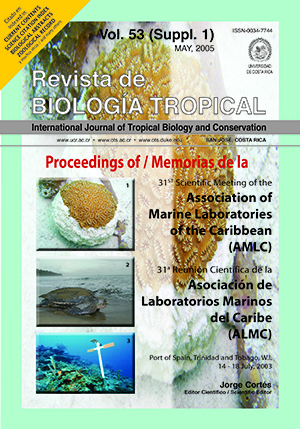Resumen
La costa Atlántica del Condado de Broward, Florida (EEUU) es paralela a una serie de arrecifes coralinos lineales de creciente profundos. Dos de estos sistemas arrecifales del Holoceno Temprano (cinco mil y siete mil años) son arrecifes coralinos sumergidos. Aunque estos arrecifes son de fácil acceso y contribuyen en forma significativa a la economía local, no existen mapas detallados de los hábitats bentónicos. Los estudios ecológicos han demostrado que diferentes comunidades bentónicas (i.e. comunidades compuestas por diferentes táxones) existen a lo largo de gradientes espaciales de todos los arrecifes. Como estos estudios tienen limitaciones temporales y espaciales, hicimos sondeos acústicos con el sistema de clasificación béntica QTCView V basado en transductores de 50 kHz, como un método alternativo para producir mapas de hábitat. De la información acústica de una área de 3.1 km2, se generaron mapas predictivos para el área. Posteriormente se compararon con mapas de hábitat hechos in situ y con batimetría generada con una Sonda de Batimetría Láser Aérea (Laser Airborne Depth Sounder: LADS), para comprobar la precisión de los datos del sensor remoto. Se usó una matriz de errores para determinar la fidelidad del modelo espacial predictivo, generado acústicamente, en comparación con los mapas derivados in situ y las bases de datos LADS. Un Análisis de Confusión (errores de predicción) de 100 puntos al azar mostró que el sistema podía diferenciar arrecifes de áreas cubiertas con escombros y arena, con una precisión del 61%. Al tratar de ver diferencias espaciales más sutiles, por ejemplo, entre diferentes comunidades arrecifales, la precisión bajó al 40%. Discutimos hasta que punto una síntesis de técnicas acústicas e in situ pueden proveer mapas de hábitat precisos en ambientes de arrecifes coralinos, y concluimos que los métodos acústicos pueden predecir la extensión espacial y la composición de al menos tres comunidades biológicas.Citas
Anderson, J.T., R.S. Gregory & W.T. Collins. 2002. Acoustic classification of marine habitats in coastal Newfoundland. ICES J. Mar. Sci. 59: 156-167.
Andrefouet, S., R. Berkelmans, L. Odriozola, T. Done, J. Oliver, & F. Muller-Karger. 2002. Choosing the appropriate spatial resolution for monitoring coral bleaching events using remote sensing. Coral Reefs 21: 147-154.
Clark, K.R. & R.M. Warwick. 2001. Change in marine communities: An approach to statistical analysis and interpretation. 2nd Ed. Primer-E. Plymouth, U.K. 164 p.
Dodge, R.E., A. Logan & A. Antonius. 1982. Quantitative reef assessment studies in Bermuda: A comparison of methods and preliminary results. Bull. Mar. Sci. 32: 745-760.
Duane, D.B. and E.P. Meisburger. 1969. Geomorphology and Sediments of the Nearshore Continental Shelf Miami to Palm Beach, Florida. U.S. Army Corps of Engineers Technical Memorandum No. 29. 47 p.
Goldberg, W.M. (1979) Shelf temperatures and reef growth on the south-east Florida coast. Nature 278: 669-670.
Green, E.P., P.J. Mumby, A.J. Edwards & C.D. Clark. 2000. Remote sensing handbook for tropical coastal mangement. UNESCO. 316 p.
Hamilton, L.J., P.J. Mulhearn, & R. Poeckert. 1999. Comparison of RoxAnn and QTC-View acoustic bottom classification system performance for the Cairns area, Great Barrier Reef, Australia. Cont. Shelf. Res. 19: 1577-1597.
Hochberg, E. & M. Atkinson. 2000. Spectral discrimination of coral reef benthic communities. Coral Reefs 19: 164-171.
Holden, H. & E. Ledrew. 1999. Hyperspectral identification of coral reef features. Int. J. Rem. Sens. 20: 2545-2563.
Janssen, L.L.F. & F.J.M., van der Wel. 1994. Accuracy assessment of satellite derived land-cover data: a review. Photogrammetric Engineering and Remote Sensing 60: 419-426.
Johnston, K., J.M. Ver Hoef, K. Krivoruchko & N. Lucas. 2001. Using ArcGIS Geostatistical Analyst. ESRI Press, Redlands CA. 300 p.
Legendre, P., K.E. Ellingsen, E. Bjørnbom & P. Casgrain. 2002. Acoustic seabed classification: Improved statistical method. Can. J. Fish. Aquat. Sci. 59: 1085-1089.
Lighty, R.G. 1977. Relict shelf-edge Holocene coral reef: southeast coast of Florida. Proc. 3rd Int. Coral Reef Symp. 2: 215-221.
Moyer, R.P., B. Riegl, K. Bank & R.E. Dodge. 2003. Spatial patterns and ecology of benthic communities on a high-latitude South Florida (Broward County, USA) reef system. Coral Reefs 22: 447-464.
Mumby, P.J., E.P. Green, A.J. Edwards & C.D. Clark. 1997. Coral reef habitat mapping: How much detail can remote sensing provide? Mar. Biol. 130: 193-202.
Preston, J.M., W.T. Collins, D.C. Mosher, R.H. Poeckert & R.H. Kuwahara. 1999. The strength of correlations between geotechnical variables and acoustic classifications. Proc. MTS/IEEE OCEANS’99 Conf. Pp. 1123-1128.
Preston, J.M., A.C. Christney, L.S. Beran, W.T. Collins & R.A. McConnaughey. 2002. Objective measures of acoustic diversity for benthic habitat characterization. Symp. Effects of Fisheries on Benthic Habitats: Linking Geology, Biology, Socioeconomy and Management, Tampa, Florida. 45 p.
Quester Tangent Corp. 2001. QTC View Acoustic seabed classification. User Guide 1.00. Sidney, B.C. 39 p.
Quester Tangent Corp. 2002. QTC Impact User Guide 3.00. Sidney, B.C. 125 p.
Riegl, B. & W.E. Piller. 2003. Possible refugia for reefs in times of environmental stress. Int. J. Earth Sci. 92: 520-531.
Wellington, M. 2001. The laser airborne depth sounder (LADS): A broad range of applications, environmental conditions and commercial models. Hydro Intl. 5(3): 6-9.
##plugins.facebook.comentarios##

Esta obra está bajo una licencia internacional Creative Commons Atribución 4.0.
Derechos de autor 2005 Revista de Biología Tropical


